Exploring Therapeutic Relationship and Therapeutic Engagement in Healthcare
VerifiedAdded on 2023/06/13
|15
|4139
|379
AI Summary
This paper discusses the definition and core pillars of therapeutic relationship, theories that explain the relationship, positive and negative impacts, barriers, and factors that enhance the relationship. It also explores therapeutic engagement and its impact on patient care.
Contribute Materials
Your contribution can guide someone’s learning journey. Share your
documents today.

Introduction
Therapeutic relationship refers to perceived relationship and care that works towards
improvement of the quality of healthcare of patient. Therapeutic relationship is known to
contribute to patient care and has a direct impact on patient's clinical outcome. There are many
different theories that explore therapeutic relationship and elucidate some examples of
therapeutic relationship. Therapeutic engagement employs a teamwork approach to patient care
and also contributes to patient’s clinical outcome. Therapeutic engagement has both positive and
negative impact on health as therapeutic engagement improves the quality of healthcare (Melanie
et al. 2014). In addition, therapeutic relation has both positive and negative impact on healthcare.
I think therapeutic relationship is not working well for a number of reasons that need to be
addressed for the therapeutic relationship to work in most healthcare facilities (Northway 2017).
One of the reasons why therapeutic relationship is not working include busy schedule among
therapists and the strategy is argued to be more involving (Sjögren et al. 2017). There are many
aspects of care that are a barrier to effective therapeutic relationship with the healthcare setting.
One example of this is breakdown in communication that has greatly affected the
implementation of the strategy. There are many factors that enhance therapeutic relationship and
therapeutic engagement during patient care. The aim of this paper is to explore various aspects of
the therapeutic relationship and therapeutic engagement.
Therapeutic Relationship
1
Therapeutic relationship refers to perceived relationship and care that works towards
improvement of the quality of healthcare of patient. Therapeutic relationship is known to
contribute to patient care and has a direct impact on patient's clinical outcome. There are many
different theories that explore therapeutic relationship and elucidate some examples of
therapeutic relationship. Therapeutic engagement employs a teamwork approach to patient care
and also contributes to patient’s clinical outcome. Therapeutic engagement has both positive and
negative impact on health as therapeutic engagement improves the quality of healthcare (Melanie
et al. 2014). In addition, therapeutic relation has both positive and negative impact on healthcare.
I think therapeutic relationship is not working well for a number of reasons that need to be
addressed for the therapeutic relationship to work in most healthcare facilities (Northway 2017).
One of the reasons why therapeutic relationship is not working include busy schedule among
therapists and the strategy is argued to be more involving (Sjögren et al. 2017). There are many
aspects of care that are a barrier to effective therapeutic relationship with the healthcare setting.
One example of this is breakdown in communication that has greatly affected the
implementation of the strategy. There are many factors that enhance therapeutic relationship and
therapeutic engagement during patient care. The aim of this paper is to explore various aspects of
the therapeutic relationship and therapeutic engagement.
Therapeutic Relationship
1
Secure Best Marks with AI Grader
Need help grading? Try our AI Grader for instant feedback on your assignments.

Therapeutic Relationship
Therapeutic relationship can be defined in the broad perspective as the positive relationship
between professional practitioners and client as perceived by clients. According to Mottram
(2009), the therapeutic relationship is client’s emotional perception of care relationship that
exists between clients and therapist that is connected through positive care, support and
perceived safety from life-threatening situations. This implies that therapeutic relationship is
developed through high-quality care and respect for a client that is moderated by the professional
code of conduct and standards of practice. Nursing practitioners are the forefront caregivers that
have to prioritize the therapeutic relationship with clients. Therapeutic relationship has some
core pillars that works towards the establishment of this relationship within the healthcare
setting. Firstly, clients’ expectation of the service is vital for establishing a positive therapeutic
relationship with patients. Secondly, emotional support that drives the healthcare practitioner to
provide care to a patient is another core pillar that makes a therapeutic relationship works.
Thirdly, compassion and empathy are other two pillars of the therapeutic relationship that bear
the element of emotional feelings of the patient’s situation and the need to care for those patients
suffering (Margreet 2014).
Therapeutic Engagement
The general meaning of therapeutic engagement may refer to engagement of therapist into giving
vital care to clients. For instance, providing treatment to a patient with dementia who require
highly specialized complex treatment especially the multidisciplinary care. In addition, staff
engagement during complex care help ensure that those life-threatening situations are handled
with the care needed of healthcare practitioners. (Richardson et al. 2015)
Theories of the therapeutic relationship
Therapeutic relationship can be defined in the broad perspective as the positive relationship
between professional practitioners and client as perceived by clients. According to Mottram
(2009), the therapeutic relationship is client’s emotional perception of care relationship that
exists between clients and therapist that is connected through positive care, support and
perceived safety from life-threatening situations. This implies that therapeutic relationship is
developed through high-quality care and respect for a client that is moderated by the professional
code of conduct and standards of practice. Nursing practitioners are the forefront caregivers that
have to prioritize the therapeutic relationship with clients. Therapeutic relationship has some
core pillars that works towards the establishment of this relationship within the healthcare
setting. Firstly, clients’ expectation of the service is vital for establishing a positive therapeutic
relationship with patients. Secondly, emotional support that drives the healthcare practitioner to
provide care to a patient is another core pillar that makes a therapeutic relationship works.
Thirdly, compassion and empathy are other two pillars of the therapeutic relationship that bear
the element of emotional feelings of the patient’s situation and the need to care for those patients
suffering (Margreet 2014).
Therapeutic Engagement
The general meaning of therapeutic engagement may refer to engagement of therapist into giving
vital care to clients. For instance, providing treatment to a patient with dementia who require
highly specialized complex treatment especially the multidisciplinary care. In addition, staff
engagement during complex care help ensure that those life-threatening situations are handled
with the care needed of healthcare practitioners. (Richardson et al. 2015)
Theories of the therapeutic relationship
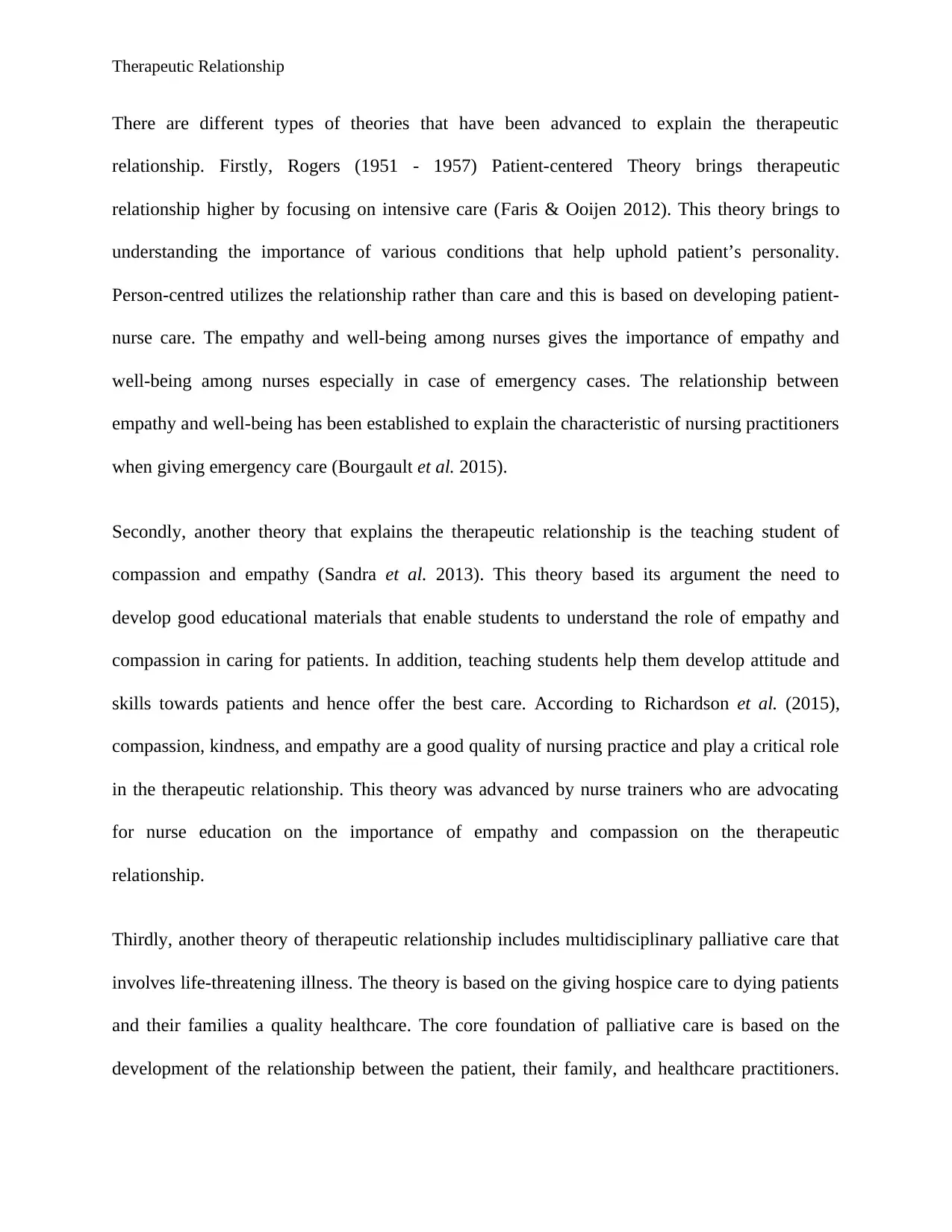
Therapeutic Relationship
There are different types of theories that have been advanced to explain the therapeutic
relationship. Firstly, Rogers (1951 - 1957) Patient-centered Theory brings therapeutic
relationship higher by focusing on intensive care (Faris & Ooijen 2012). This theory brings to
understanding the importance of various conditions that help uphold patient’s personality.
Person-centred utilizes the relationship rather than care and this is based on developing patient-
nurse care. The empathy and well-being among nurses gives the importance of empathy and
well-being among nurses especially in case of emergency cases. The relationship between
empathy and well-being has been established to explain the characteristic of nursing practitioners
when giving emergency care (Bourgault et al. 2015).
Secondly, another theory that explains the therapeutic relationship is the teaching student of
compassion and empathy (Sandra et al. 2013). This theory based its argument the need to
develop good educational materials that enable students to understand the role of empathy and
compassion in caring for patients. In addition, teaching students help them develop attitude and
skills towards patients and hence offer the best care. According to Richardson et al. (2015),
compassion, kindness, and empathy are a good quality of nursing practice and play a critical role
in the therapeutic relationship. This theory was advanced by nurse trainers who are advocating
for nurse education on the importance of empathy and compassion on the therapeutic
relationship.
Thirdly, another theory of therapeutic relationship includes multidisciplinary palliative care that
involves life-threatening illness. The theory is based on the giving hospice care to dying patients
and their families a quality healthcare. The core foundation of palliative care is based on the
development of the relationship between the patient, their family, and healthcare practitioners.
There are different types of theories that have been advanced to explain the therapeutic
relationship. Firstly, Rogers (1951 - 1957) Patient-centered Theory brings therapeutic
relationship higher by focusing on intensive care (Faris & Ooijen 2012). This theory brings to
understanding the importance of various conditions that help uphold patient’s personality.
Person-centred utilizes the relationship rather than care and this is based on developing patient-
nurse care. The empathy and well-being among nurses gives the importance of empathy and
well-being among nurses especially in case of emergency cases. The relationship between
empathy and well-being has been established to explain the characteristic of nursing practitioners
when giving emergency care (Bourgault et al. 2015).
Secondly, another theory that explains the therapeutic relationship is the teaching student of
compassion and empathy (Sandra et al. 2013). This theory based its argument the need to
develop good educational materials that enable students to understand the role of empathy and
compassion in caring for patients. In addition, teaching students help them develop attitude and
skills towards patients and hence offer the best care. According to Richardson et al. (2015),
compassion, kindness, and empathy are a good quality of nursing practice and play a critical role
in the therapeutic relationship. This theory was advanced by nurse trainers who are advocating
for nurse education on the importance of empathy and compassion on the therapeutic
relationship.
Thirdly, another theory of therapeutic relationship includes multidisciplinary palliative care that
involves life-threatening illness. The theory is based on the giving hospice care to dying patients
and their families a quality healthcare. The core foundation of palliative care is based on the
development of the relationship between the patient, their family, and healthcare practitioners.
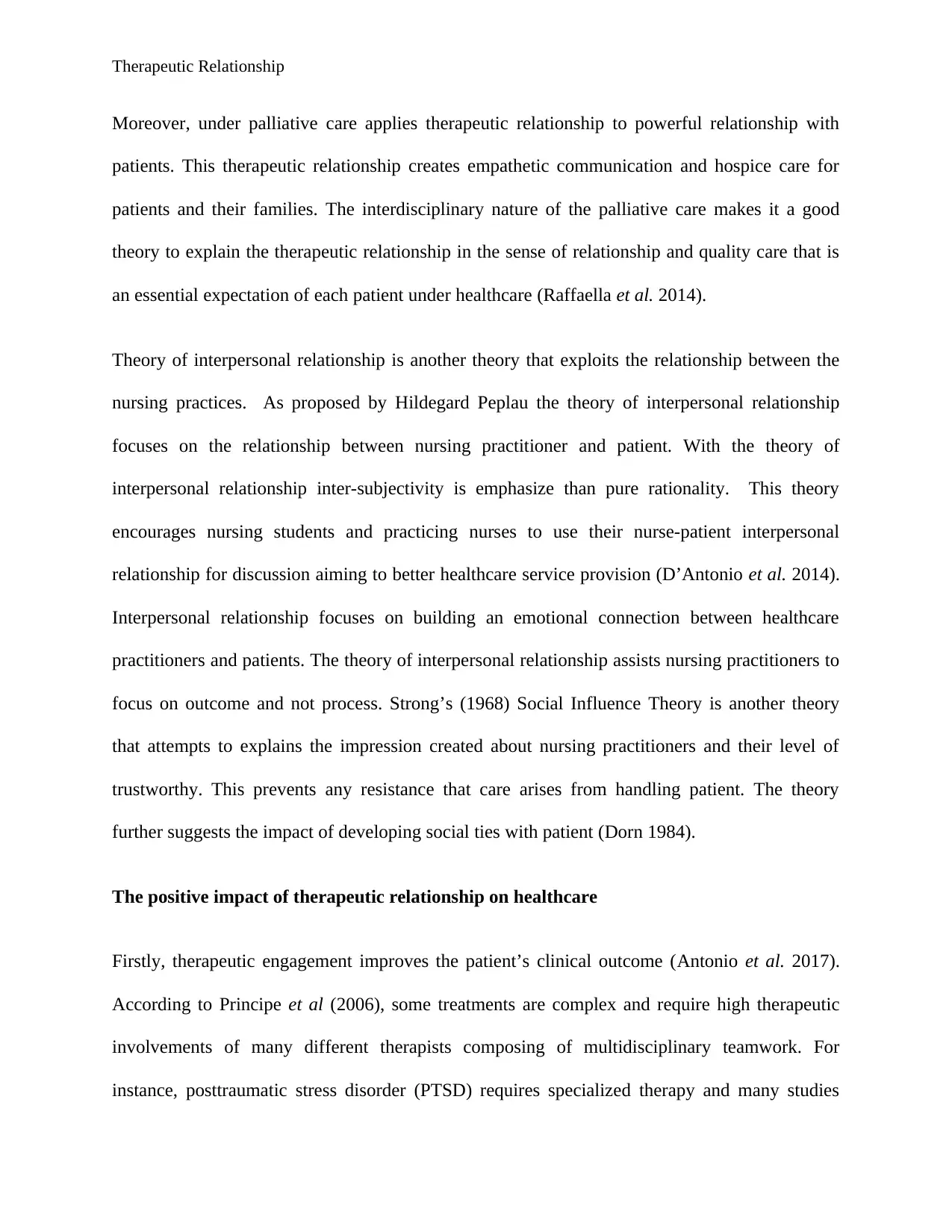
Therapeutic Relationship
Moreover, under palliative care applies therapeutic relationship to powerful relationship with
patients. This therapeutic relationship creates empathetic communication and hospice care for
patients and their families. The interdisciplinary nature of the palliative care makes it a good
theory to explain the therapeutic relationship in the sense of relationship and quality care that is
an essential expectation of each patient under healthcare (Raffaella et al. 2014).
Theory of interpersonal relationship is another theory that exploits the relationship between the
nursing practices. As proposed by Hildegard Peplau the theory of interpersonal relationship
focuses on the relationship between nursing practitioner and patient. With the theory of
interpersonal relationship inter-subjectivity is emphasize than pure rationality. This theory
encourages nursing students and practicing nurses to use their nurse-patient interpersonal
relationship for discussion aiming to better healthcare service provision (D’Antonio et al. 2014).
Interpersonal relationship focuses on building an emotional connection between healthcare
practitioners and patients. The theory of interpersonal relationship assists nursing practitioners to
focus on outcome and not process. Strong’s (1968) Social Influence Theory is another theory
that attempts to explains the impression created about nursing practitioners and their level of
trustworthy. This prevents any resistance that care arises from handling patient. The theory
further suggests the impact of developing social ties with patient (Dorn 1984).
The positive impact of therapeutic relationship on healthcare
Firstly, therapeutic engagement improves the patient’s clinical outcome (Antonio et al. 2017).
According to Principe et al (2006), some treatments are complex and require high therapeutic
involvements of many different therapists composing of multidisciplinary teamwork. For
instance, posttraumatic stress disorder (PTSD) requires specialized therapy and many studies
Moreover, under palliative care applies therapeutic relationship to powerful relationship with
patients. This therapeutic relationship creates empathetic communication and hospice care for
patients and their families. The interdisciplinary nature of the palliative care makes it a good
theory to explain the therapeutic relationship in the sense of relationship and quality care that is
an essential expectation of each patient under healthcare (Raffaella et al. 2014).
Theory of interpersonal relationship is another theory that exploits the relationship between the
nursing practices. As proposed by Hildegard Peplau the theory of interpersonal relationship
focuses on the relationship between nursing practitioner and patient. With the theory of
interpersonal relationship inter-subjectivity is emphasize than pure rationality. This theory
encourages nursing students and practicing nurses to use their nurse-patient interpersonal
relationship for discussion aiming to better healthcare service provision (D’Antonio et al. 2014).
Interpersonal relationship focuses on building an emotional connection between healthcare
practitioners and patients. The theory of interpersonal relationship assists nursing practitioners to
focus on outcome and not process. Strong’s (1968) Social Influence Theory is another theory
that attempts to explains the impression created about nursing practitioners and their level of
trustworthy. This prevents any resistance that care arises from handling patient. The theory
further suggests the impact of developing social ties with patient (Dorn 1984).
The positive impact of therapeutic relationship on healthcare
Firstly, therapeutic engagement improves the patient’s clinical outcome (Antonio et al. 2017).
According to Principe et al (2006), some treatments are complex and require high therapeutic
involvements of many different therapists composing of multidisciplinary teamwork. For
instance, posttraumatic stress disorder (PTSD) requires specialized therapy and many studies
Secure Best Marks with AI Grader
Need help grading? Try our AI Grader for instant feedback on your assignments.
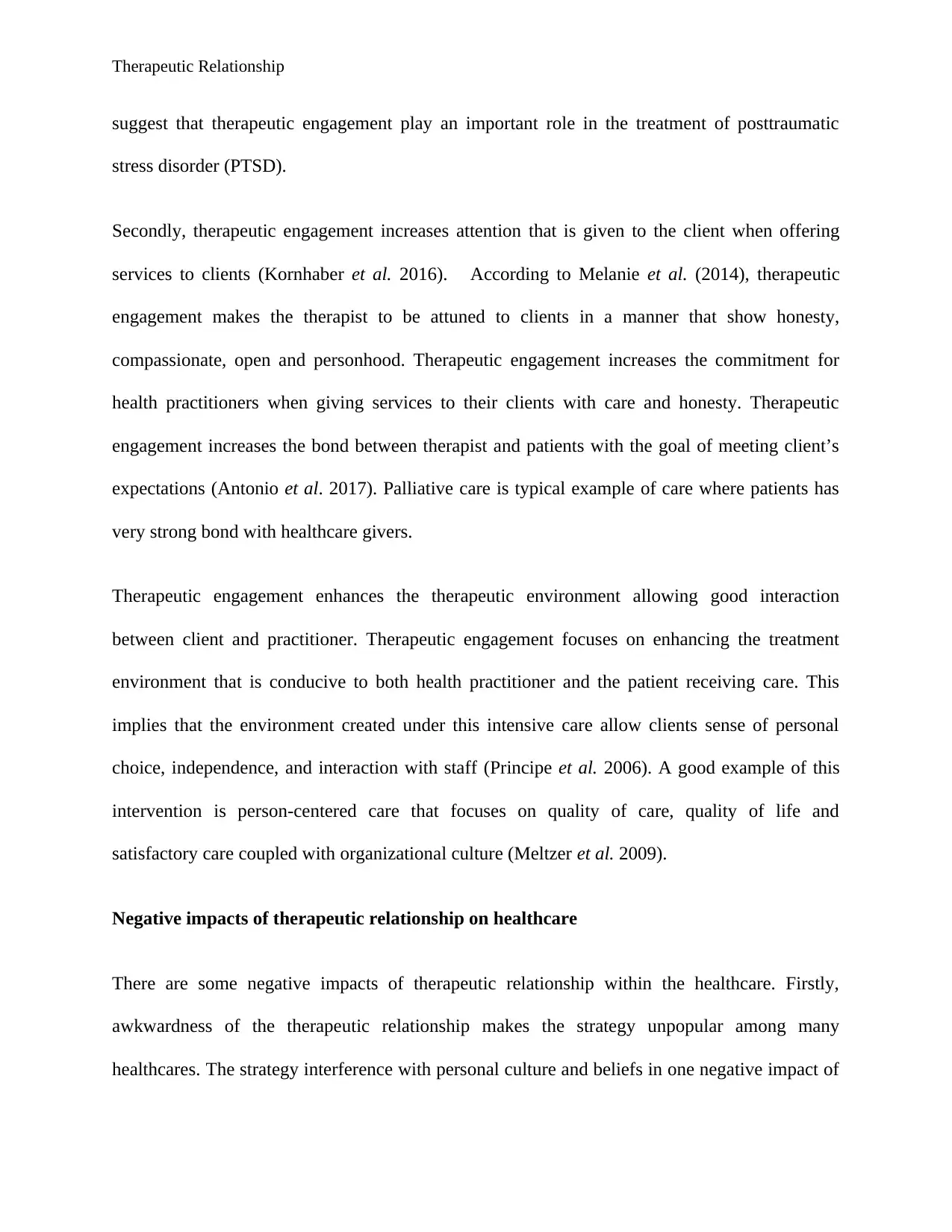
Therapeutic Relationship
suggest that therapeutic engagement play an important role in the treatment of posttraumatic
stress disorder (PTSD).
Secondly, therapeutic engagement increases attention that is given to the client when offering
services to clients (Kornhaber et al. 2016). According to Melanie et al. (2014), therapeutic
engagement makes the therapist to be attuned to clients in a manner that show honesty,
compassionate, open and personhood. Therapeutic engagement increases the commitment for
health practitioners when giving services to their clients with care and honesty. Therapeutic
engagement increases the bond between therapist and patients with the goal of meeting client’s
expectations (Antonio et al. 2017). Palliative care is typical example of care where patients has
very strong bond with healthcare givers.
Therapeutic engagement enhances the therapeutic environment allowing good interaction
between client and practitioner. Therapeutic engagement focuses on enhancing the treatment
environment that is conducive to both health practitioner and the patient receiving care. This
implies that the environment created under this intensive care allow clients sense of personal
choice, independence, and interaction with staff (Principe et al. 2006). A good example of this
intervention is person-centered care that focuses on quality of care, quality of life and
satisfactory care coupled with organizational culture (Meltzer et al. 2009).
Negative impacts of therapeutic relationship on healthcare
There are some negative impacts of therapeutic relationship within the healthcare. Firstly,
awkwardness of the therapeutic relationship makes the strategy unpopular among many
healthcares. The strategy interference with personal culture and beliefs in one negative impact of
suggest that therapeutic engagement play an important role in the treatment of posttraumatic
stress disorder (PTSD).
Secondly, therapeutic engagement increases attention that is given to the client when offering
services to clients (Kornhaber et al. 2016). According to Melanie et al. (2014), therapeutic
engagement makes the therapist to be attuned to clients in a manner that show honesty,
compassionate, open and personhood. Therapeutic engagement increases the commitment for
health practitioners when giving services to their clients with care and honesty. Therapeutic
engagement increases the bond between therapist and patients with the goal of meeting client’s
expectations (Antonio et al. 2017). Palliative care is typical example of care where patients has
very strong bond with healthcare givers.
Therapeutic engagement enhances the therapeutic environment allowing good interaction
between client and practitioner. Therapeutic engagement focuses on enhancing the treatment
environment that is conducive to both health practitioner and the patient receiving care. This
implies that the environment created under this intensive care allow clients sense of personal
choice, independence, and interaction with staff (Principe et al. 2006). A good example of this
intervention is person-centered care that focuses on quality of care, quality of life and
satisfactory care coupled with organizational culture (Meltzer et al. 2009).
Negative impacts of therapeutic relationship on healthcare
There are some negative impacts of therapeutic relationship within the healthcare. Firstly,
awkwardness of the therapeutic relationship makes the strategy unpopular among many
healthcares. The strategy interference with personal culture and beliefs in one negative impact of
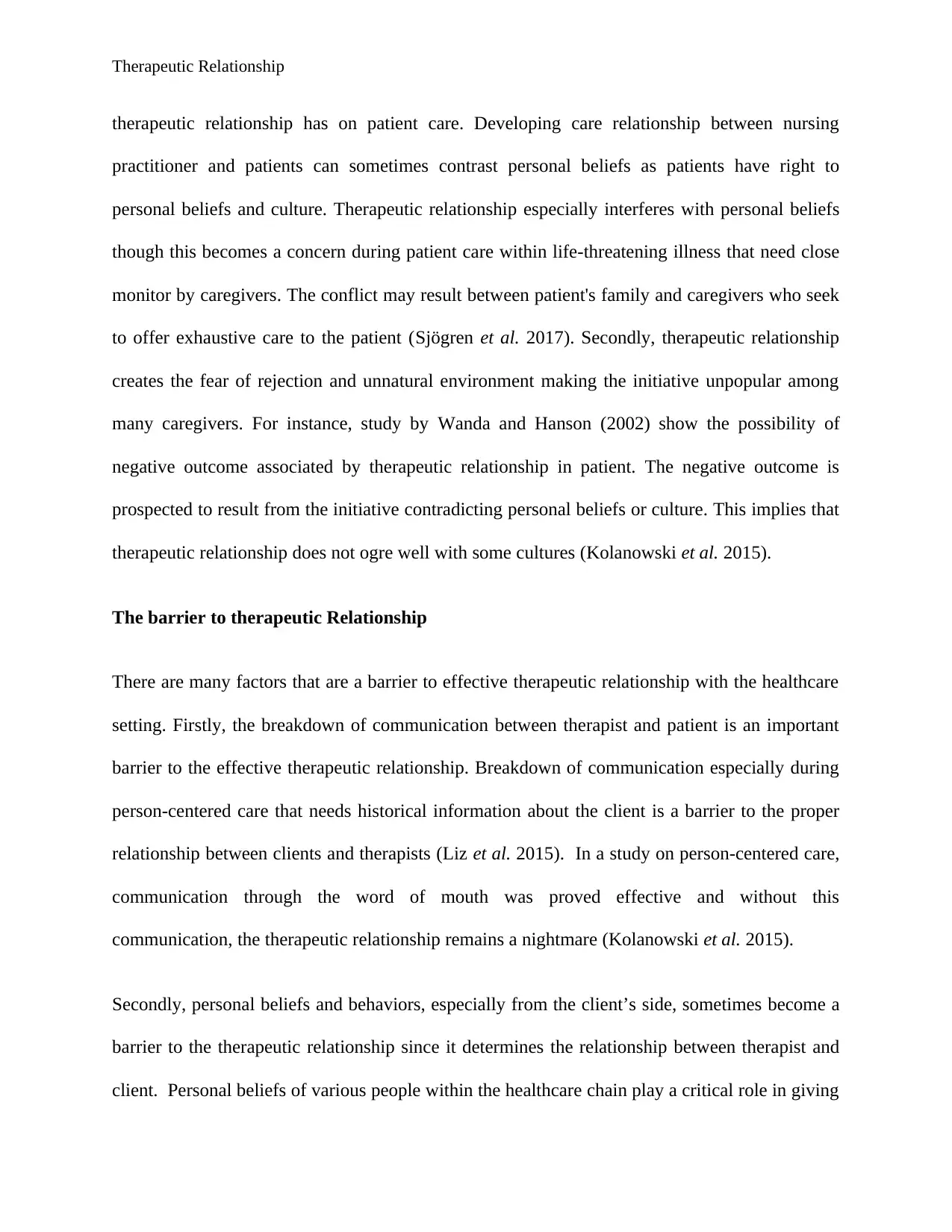
Therapeutic Relationship
therapeutic relationship has on patient care. Developing care relationship between nursing
practitioner and patients can sometimes contrast personal beliefs as patients have right to
personal beliefs and culture. Therapeutic relationship especially interferes with personal beliefs
though this becomes a concern during patient care within life-threatening illness that need close
monitor by caregivers. The conflict may result between patient's family and caregivers who seek
to offer exhaustive care to the patient (Sjögren et al. 2017). Secondly, therapeutic relationship
creates the fear of rejection and unnatural environment making the initiative unpopular among
many caregivers. For instance, study by Wanda and Hanson (2002) show the possibility of
negative outcome associated by therapeutic relationship in patient. The negative outcome is
prospected to result from the initiative contradicting personal beliefs or culture. This implies that
therapeutic relationship does not ogre well with some cultures (Kolanowski et al. 2015).
The barrier to therapeutic Relationship
There are many factors that are a barrier to effective therapeutic relationship with the healthcare
setting. Firstly, the breakdown of communication between therapist and patient is an important
barrier to the effective therapeutic relationship. Breakdown of communication especially during
person-centered care that needs historical information about the client is a barrier to the proper
relationship between clients and therapists (Liz et al. 2015). In a study on person-centered care,
communication through the word of mouth was proved effective and without this
communication, the therapeutic relationship remains a nightmare (Kolanowski et al. 2015).
Secondly, personal beliefs and behaviors, especially from the client’s side, sometimes become a
barrier to the therapeutic relationship since it determines the relationship between therapist and
client. Personal beliefs of various people within the healthcare chain play a critical role in giving
therapeutic relationship has on patient care. Developing care relationship between nursing
practitioner and patients can sometimes contrast personal beliefs as patients have right to
personal beliefs and culture. Therapeutic relationship especially interferes with personal beliefs
though this becomes a concern during patient care within life-threatening illness that need close
monitor by caregivers. The conflict may result between patient's family and caregivers who seek
to offer exhaustive care to the patient (Sjögren et al. 2017). Secondly, therapeutic relationship
creates the fear of rejection and unnatural environment making the initiative unpopular among
many caregivers. For instance, study by Wanda and Hanson (2002) show the possibility of
negative outcome associated by therapeutic relationship in patient. The negative outcome is
prospected to result from the initiative contradicting personal beliefs or culture. This implies that
therapeutic relationship does not ogre well with some cultures (Kolanowski et al. 2015).
The barrier to therapeutic Relationship
There are many factors that are a barrier to effective therapeutic relationship with the healthcare
setting. Firstly, the breakdown of communication between therapist and patient is an important
barrier to the effective therapeutic relationship. Breakdown of communication especially during
person-centered care that needs historical information about the client is a barrier to the proper
relationship between clients and therapists (Liz et al. 2015). In a study on person-centered care,
communication through the word of mouth was proved effective and without this
communication, the therapeutic relationship remains a nightmare (Kolanowski et al. 2015).
Secondly, personal beliefs and behaviors, especially from the client’s side, sometimes become a
barrier to the therapeutic relationship since it determines the relationship between therapist and
client. Personal beliefs of various people within the healthcare chain play a critical role in giving
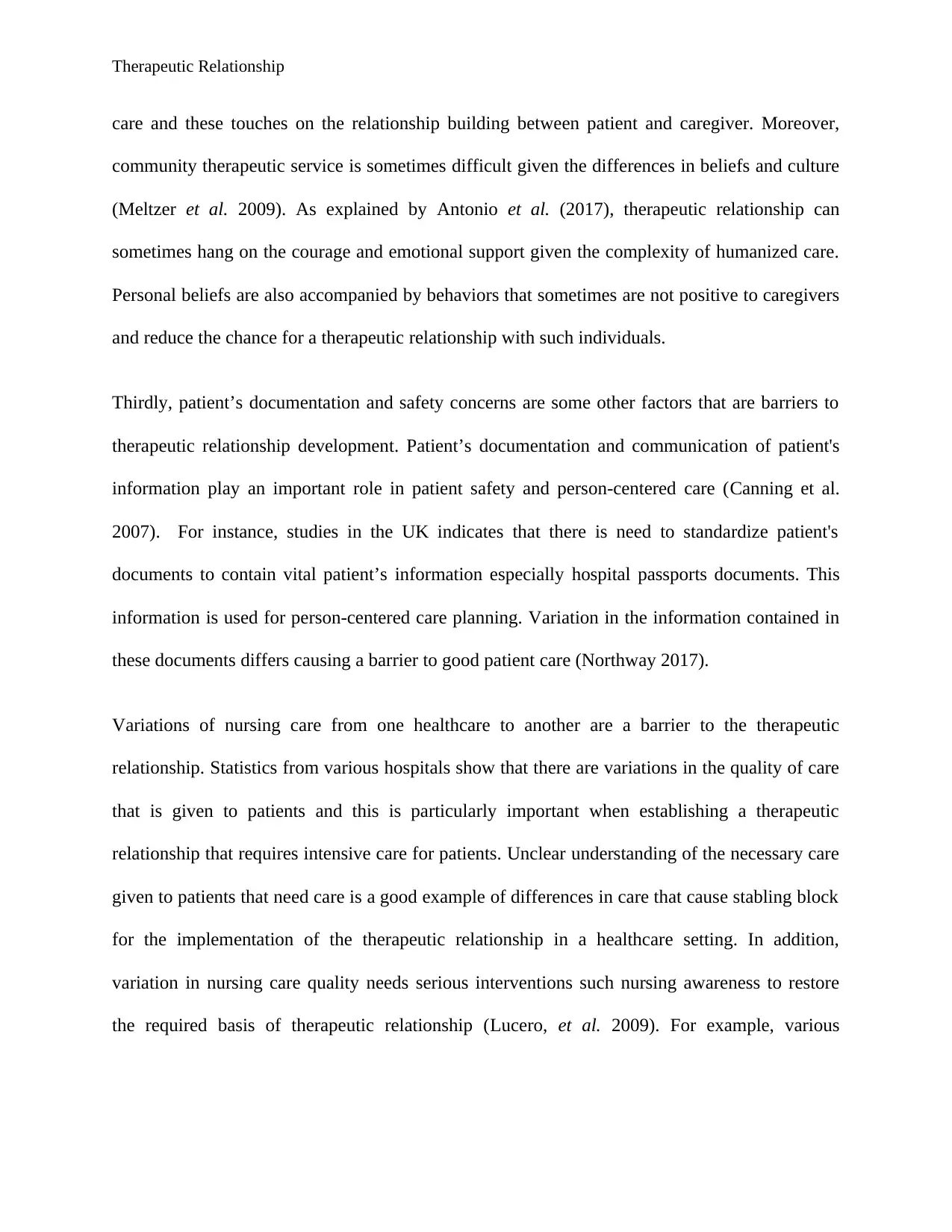
Therapeutic Relationship
care and these touches on the relationship building between patient and caregiver. Moreover,
community therapeutic service is sometimes difficult given the differences in beliefs and culture
(Meltzer et al. 2009). As explained by Antonio et al. (2017), therapeutic relationship can
sometimes hang on the courage and emotional support given the complexity of humanized care.
Personal beliefs are also accompanied by behaviors that sometimes are not positive to caregivers
and reduce the chance for a therapeutic relationship with such individuals.
Thirdly, patient’s documentation and safety concerns are some other factors that are barriers to
therapeutic relationship development. Patient’s documentation and communication of patient's
information play an important role in patient safety and person-centered care (Canning et al.
2007). For instance, studies in the UK indicates that there is need to standardize patient's
documents to contain vital patient’s information especially hospital passports documents. This
information is used for person-centered care planning. Variation in the information contained in
these documents differs causing a barrier to good patient care (Northway 2017).
Variations of nursing care from one healthcare to another are a barrier to the therapeutic
relationship. Statistics from various hospitals show that there are variations in the quality of care
that is given to patients and this is particularly important when establishing a therapeutic
relationship that requires intensive care for patients. Unclear understanding of the necessary care
given to patients that need care is a good example of differences in care that cause stabling block
for the implementation of the therapeutic relationship in a healthcare setting. In addition,
variation in nursing care quality needs serious interventions such nursing awareness to restore
the required basis of therapeutic relationship (Lucero, et al. 2009). For example, various
care and these touches on the relationship building between patient and caregiver. Moreover,
community therapeutic service is sometimes difficult given the differences in beliefs and culture
(Meltzer et al. 2009). As explained by Antonio et al. (2017), therapeutic relationship can
sometimes hang on the courage and emotional support given the complexity of humanized care.
Personal beliefs are also accompanied by behaviors that sometimes are not positive to caregivers
and reduce the chance for a therapeutic relationship with such individuals.
Thirdly, patient’s documentation and safety concerns are some other factors that are barriers to
therapeutic relationship development. Patient’s documentation and communication of patient's
information play an important role in patient safety and person-centered care (Canning et al.
2007). For instance, studies in the UK indicates that there is need to standardize patient's
documents to contain vital patient’s information especially hospital passports documents. This
information is used for person-centered care planning. Variation in the information contained in
these documents differs causing a barrier to good patient care (Northway 2017).
Variations of nursing care from one healthcare to another are a barrier to the therapeutic
relationship. Statistics from various hospitals show that there are variations in the quality of care
that is given to patients and this is particularly important when establishing a therapeutic
relationship that requires intensive care for patients. Unclear understanding of the necessary care
given to patients that need care is a good example of differences in care that cause stabling block
for the implementation of the therapeutic relationship in a healthcare setting. In addition,
variation in nursing care quality needs serious interventions such nursing awareness to restore
the required basis of therapeutic relationship (Lucero, et al. 2009). For example, various
Paraphrase This Document
Need a fresh take? Get an instant paraphrase of this document with our AI Paraphraser
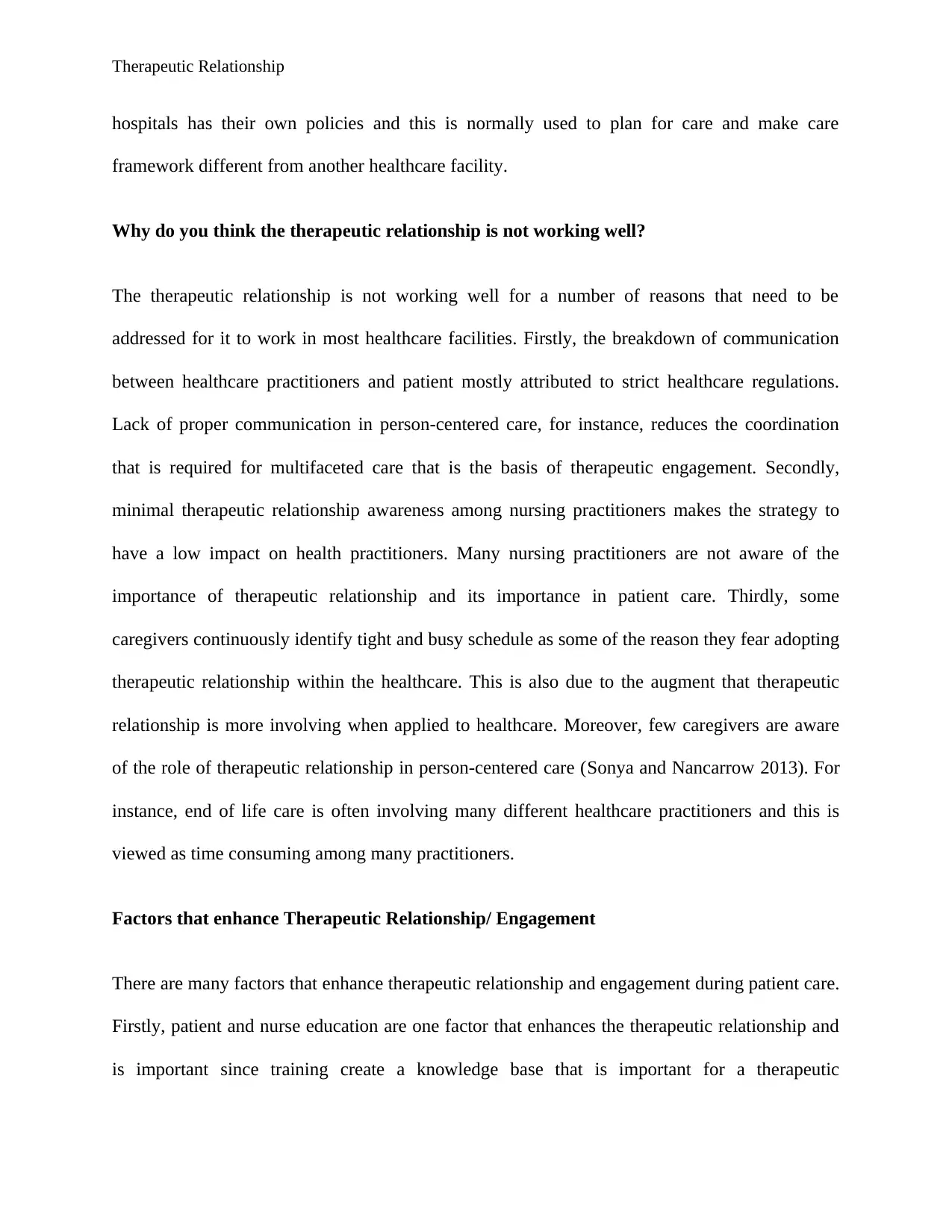
Therapeutic Relationship
hospitals has their own policies and this is normally used to plan for care and make care
framework different from another healthcare facility.
Why do you think the therapeutic relationship is not working well?
The therapeutic relationship is not working well for a number of reasons that need to be
addressed for it to work in most healthcare facilities. Firstly, the breakdown of communication
between healthcare practitioners and patient mostly attributed to strict healthcare regulations.
Lack of proper communication in person-centered care, for instance, reduces the coordination
that is required for multifaceted care that is the basis of therapeutic engagement. Secondly,
minimal therapeutic relationship awareness among nursing practitioners makes the strategy to
have a low impact on health practitioners. Many nursing practitioners are not aware of the
importance of therapeutic relationship and its importance in patient care. Thirdly, some
caregivers continuously identify tight and busy schedule as some of the reason they fear adopting
therapeutic relationship within the healthcare. This is also due to the augment that therapeutic
relationship is more involving when applied to healthcare. Moreover, few caregivers are aware
of the role of therapeutic relationship in person-centered care (Sonya and Nancarrow 2013). For
instance, end of life care is often involving many different healthcare practitioners and this is
viewed as time consuming among many practitioners.
Factors that enhance Therapeutic Relationship/ Engagement
There are many factors that enhance therapeutic relationship and engagement during patient care.
Firstly, patient and nurse education are one factor that enhances the therapeutic relationship and
is important since training create a knowledge base that is important for a therapeutic
hospitals has their own policies and this is normally used to plan for care and make care
framework different from another healthcare facility.
Why do you think the therapeutic relationship is not working well?
The therapeutic relationship is not working well for a number of reasons that need to be
addressed for it to work in most healthcare facilities. Firstly, the breakdown of communication
between healthcare practitioners and patient mostly attributed to strict healthcare regulations.
Lack of proper communication in person-centered care, for instance, reduces the coordination
that is required for multifaceted care that is the basis of therapeutic engagement. Secondly,
minimal therapeutic relationship awareness among nursing practitioners makes the strategy to
have a low impact on health practitioners. Many nursing practitioners are not aware of the
importance of therapeutic relationship and its importance in patient care. Thirdly, some
caregivers continuously identify tight and busy schedule as some of the reason they fear adopting
therapeutic relationship within the healthcare. This is also due to the augment that therapeutic
relationship is more involving when applied to healthcare. Moreover, few caregivers are aware
of the role of therapeutic relationship in person-centered care (Sonya and Nancarrow 2013). For
instance, end of life care is often involving many different healthcare practitioners and this is
viewed as time consuming among many practitioners.
Factors that enhance Therapeutic Relationship/ Engagement
There are many factors that enhance therapeutic relationship and engagement during patient care.
Firstly, patient and nurse education are one factor that enhances the therapeutic relationship and
is important since training create a knowledge base that is important for a therapeutic
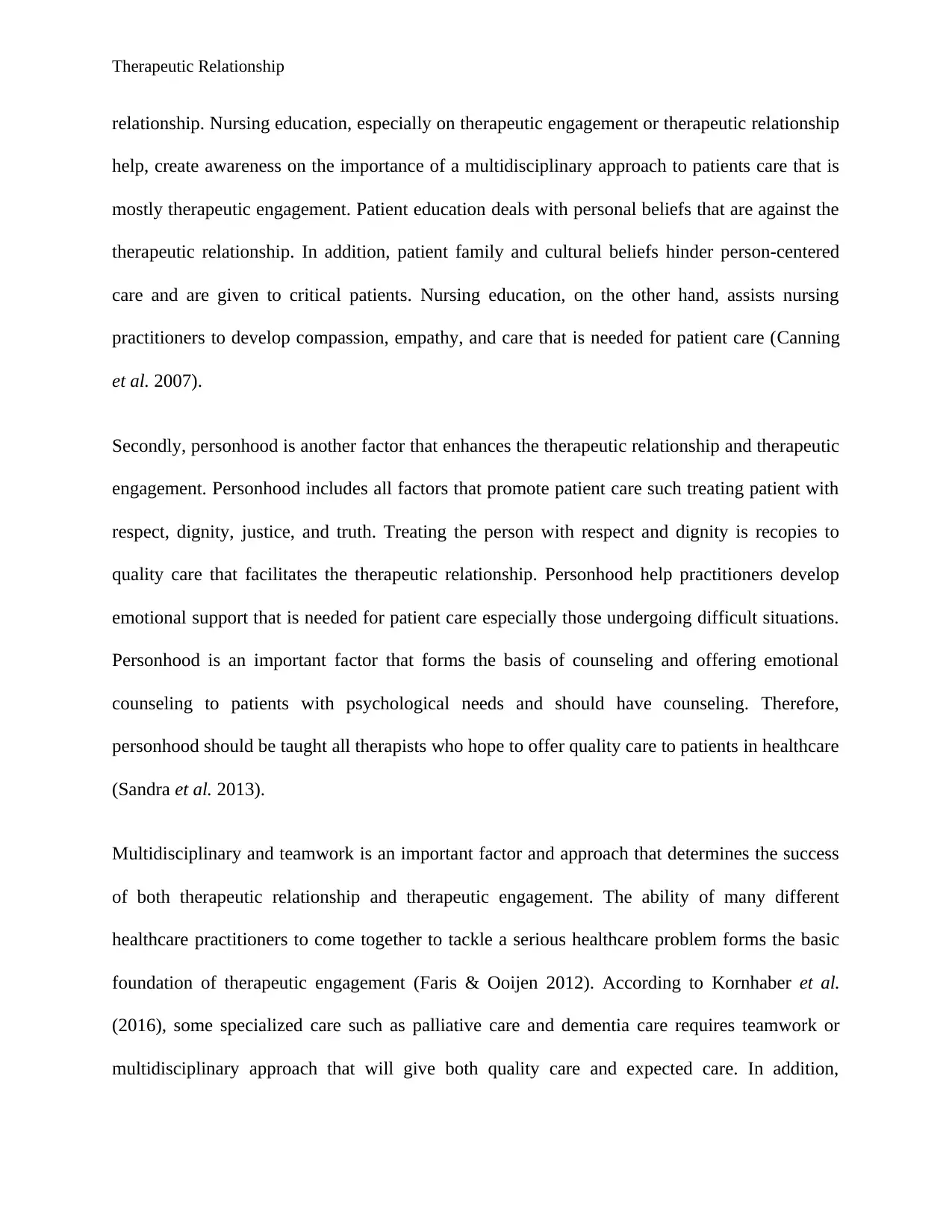
Therapeutic Relationship
relationship. Nursing education, especially on therapeutic engagement or therapeutic relationship
help, create awareness on the importance of a multidisciplinary approach to patients care that is
mostly therapeutic engagement. Patient education deals with personal beliefs that are against the
therapeutic relationship. In addition, patient family and cultural beliefs hinder person-centered
care and are given to critical patients. Nursing education, on the other hand, assists nursing
practitioners to develop compassion, empathy, and care that is needed for patient care (Canning
et al. 2007).
Secondly, personhood is another factor that enhances the therapeutic relationship and therapeutic
engagement. Personhood includes all factors that promote patient care such treating patient with
respect, dignity, justice, and truth. Treating the person with respect and dignity is recopies to
quality care that facilitates the therapeutic relationship. Personhood help practitioners develop
emotional support that is needed for patient care especially those undergoing difficult situations.
Personhood is an important factor that forms the basis of counseling and offering emotional
counseling to patients with psychological needs and should have counseling. Therefore,
personhood should be taught all therapists who hope to offer quality care to patients in healthcare
(Sandra et al. 2013).
Multidisciplinary and teamwork is an important factor and approach that determines the success
of both therapeutic relationship and therapeutic engagement. The ability of many different
healthcare practitioners to come together to tackle a serious healthcare problem forms the basic
foundation of therapeutic engagement (Faris & Ooijen 2012). According to Kornhaber et al.
(2016), some specialized care such as palliative care and dementia care requires teamwork or
multidisciplinary approach that will give both quality care and expected care. In addition,
relationship. Nursing education, especially on therapeutic engagement or therapeutic relationship
help, create awareness on the importance of a multidisciplinary approach to patients care that is
mostly therapeutic engagement. Patient education deals with personal beliefs that are against the
therapeutic relationship. In addition, patient family and cultural beliefs hinder person-centered
care and are given to critical patients. Nursing education, on the other hand, assists nursing
practitioners to develop compassion, empathy, and care that is needed for patient care (Canning
et al. 2007).
Secondly, personhood is another factor that enhances the therapeutic relationship and therapeutic
engagement. Personhood includes all factors that promote patient care such treating patient with
respect, dignity, justice, and truth. Treating the person with respect and dignity is recopies to
quality care that facilitates the therapeutic relationship. Personhood help practitioners develop
emotional support that is needed for patient care especially those undergoing difficult situations.
Personhood is an important factor that forms the basis of counseling and offering emotional
counseling to patients with psychological needs and should have counseling. Therefore,
personhood should be taught all therapists who hope to offer quality care to patients in healthcare
(Sandra et al. 2013).
Multidisciplinary and teamwork is an important factor and approach that determines the success
of both therapeutic relationship and therapeutic engagement. The ability of many different
healthcare practitioners to come together to tackle a serious healthcare problem forms the basic
foundation of therapeutic engagement (Faris & Ooijen 2012). According to Kornhaber et al.
(2016), some specialized care such as palliative care and dementia care requires teamwork or
multidisciplinary approach that will give both quality care and expected care. In addition,

Therapeutic Relationship
multidisciplinary approach to the therapeutic relationship has the potential of saving a life,
especially when handling with high dignity. This is essential for those aged care facilities where
those patients need high dignity and care to live a life full of health (Margreet 2014).
Interpersonal relationship is an aspect of patient care that enhances the therapeutic relationship.
Firstly, interpersonal relationship increases the positive patient-practitioner relationship that
leads to a good patient clinical outcome. Secondly, studies indicate that good interpersonal
relationship between patient and caregiver has the capacity to improve the patient experience.
Some of the cited outstanding interpersonal relationship skills include listening to the patient,
responding to emotional patient’s emotional needs that are key to patient improvement.
Moreover, interpersonal relationship assists patients to open up to their healthcare needs and this
important for therapeutic engagement (Principe et al. 2006).
Implementation of evidence-based research findings that concerns therapeutic relationship
enhances the therapeutic relationship. There are many different studies done on the importance
and role of both therapeutic relationship and therapeutic engagement. For instance, there are
many research findings on the role of empathy and compassion on the therapeutic relationship.
This should be used to train nursing students and nursing practitioners to enhance the application
of therapeutic relationship and engagement. In order to make a therapeutic relationship work in
most healthcare facilities, all therapists need to be trained on research finding as one aspect of
the implementation of these findings (Liz et al. 2015).
Conclusion
multidisciplinary approach to the therapeutic relationship has the potential of saving a life,
especially when handling with high dignity. This is essential for those aged care facilities where
those patients need high dignity and care to live a life full of health (Margreet 2014).
Interpersonal relationship is an aspect of patient care that enhances the therapeutic relationship.
Firstly, interpersonal relationship increases the positive patient-practitioner relationship that
leads to a good patient clinical outcome. Secondly, studies indicate that good interpersonal
relationship between patient and caregiver has the capacity to improve the patient experience.
Some of the cited outstanding interpersonal relationship skills include listening to the patient,
responding to emotional patient’s emotional needs that are key to patient improvement.
Moreover, interpersonal relationship assists patients to open up to their healthcare needs and this
important for therapeutic engagement (Principe et al. 2006).
Implementation of evidence-based research findings that concerns therapeutic relationship
enhances the therapeutic relationship. There are many different studies done on the importance
and role of both therapeutic relationship and therapeutic engagement. For instance, there are
many research findings on the role of empathy and compassion on the therapeutic relationship.
This should be used to train nursing students and nursing practitioners to enhance the application
of therapeutic relationship and engagement. In order to make a therapeutic relationship work in
most healthcare facilities, all therapists need to be trained on research finding as one aspect of
the implementation of these findings (Liz et al. 2015).
Conclusion
Secure Best Marks with AI Grader
Need help grading? Try our AI Grader for instant feedback on your assignments.
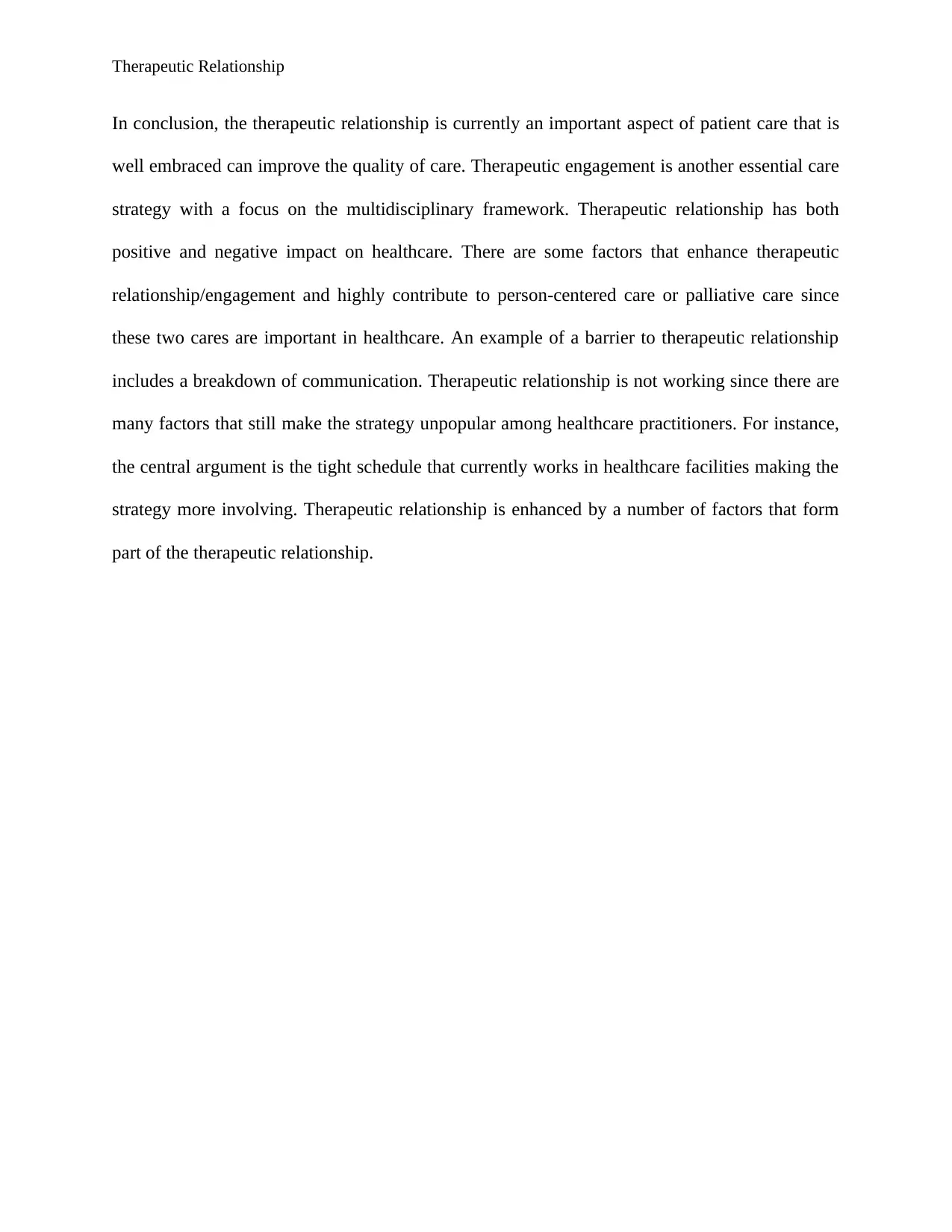
Therapeutic Relationship
In conclusion, the therapeutic relationship is currently an important aspect of patient care that is
well embraced can improve the quality of care. Therapeutic engagement is another essential care
strategy with a focus on the multidisciplinary framework. Therapeutic relationship has both
positive and negative impact on healthcare. There are some factors that enhance therapeutic
relationship/engagement and highly contribute to person-centered care or palliative care since
these two cares are important in healthcare. An example of a barrier to therapeutic relationship
includes a breakdown of communication. Therapeutic relationship is not working since there are
many factors that still make the strategy unpopular among healthcare practitioners. For instance,
the central argument is the tight schedule that currently works in healthcare facilities making the
strategy more involving. Therapeutic relationship is enhanced by a number of factors that form
part of the therapeutic relationship.
In conclusion, the therapeutic relationship is currently an important aspect of patient care that is
well embraced can improve the quality of care. Therapeutic engagement is another essential care
strategy with a focus on the multidisciplinary framework. Therapeutic relationship has both
positive and negative impact on healthcare. There are some factors that enhance therapeutic
relationship/engagement and highly contribute to person-centered care or palliative care since
these two cares are important in healthcare. An example of a barrier to therapeutic relationship
includes a breakdown of communication. Therapeutic relationship is not working since there are
many factors that still make the strategy unpopular among healthcare practitioners. For instance,
the central argument is the tight schedule that currently works in healthcare facilities making the
strategy more involving. Therapeutic relationship is enhanced by a number of factors that form
part of the therapeutic relationship.

Therapeutic Relationship
References
Antonio, R., Moreno, P. Delgado, H. Suárez-Pérez R. Lluch-Canut T., Juan F., Roldán, M. and
Montesó-Curto P. (2017) Improving the therapeutic relationship in inpatient psychiatric care:
Assessment of the therapeutic alliance and empathy after implementing evidence-based practices
resulting from participatory action research. Perspective Psychiatric Care, pp1–9. DOI:
10.1111/ppc.12238
Bourgault, P., Lavoie, S. Paul-Savoie, E., Grégoire M., Michaud, C., Gosselin, E., and Johnston,
C.C. (2015) Relationship between Empathy and Well-Being among Emergency Nurses. Journal
of Emergency Nursing, vol.41: no.8, pp 323-8. Available at:
https://www.ncbi.nlm.nih.gov/m/pubmed/25583425/
Canning, D., Rosenberg, J.P., & Yates, P., (2007) Therapeutic relationships in specialist
palliative care nursing practice. International Journal Palliative Nursing, vol.13, pp 222–229.
D’Antonio, P., Beeber L., Grayce S. and Naegled M. (2014) The future in the past: Hildegard
Peplau and interpersonal relations in nursing. Nursing Inquiry; vol.21, no.4, pp 311–317.
http://doi: 10.1111/nin.12056
Dorn F.J. (1984) The Social Influence Model: A Social Psychological Approach to Counseling.
Journal of development and counseling Vol.62, no.6, Pp 342-345
Faris, A. & Ooijen, E. (2012) Integrative counseling and psychotherapy: A relational approach.
European journal of psychotherapy and counseling, vol.14, no.34, pp 309-311
References
Antonio, R., Moreno, P. Delgado, H. Suárez-Pérez R. Lluch-Canut T., Juan F., Roldán, M. and
Montesó-Curto P. (2017) Improving the therapeutic relationship in inpatient psychiatric care:
Assessment of the therapeutic alliance and empathy after implementing evidence-based practices
resulting from participatory action research. Perspective Psychiatric Care, pp1–9. DOI:
10.1111/ppc.12238
Bourgault, P., Lavoie, S. Paul-Savoie, E., Grégoire M., Michaud, C., Gosselin, E., and Johnston,
C.C. (2015) Relationship between Empathy and Well-Being among Emergency Nurses. Journal
of Emergency Nursing, vol.41: no.8, pp 323-8. Available at:
https://www.ncbi.nlm.nih.gov/m/pubmed/25583425/
Canning, D., Rosenberg, J.P., & Yates, P., (2007) Therapeutic relationships in specialist
palliative care nursing practice. International Journal Palliative Nursing, vol.13, pp 222–229.
D’Antonio, P., Beeber L., Grayce S. and Naegled M. (2014) The future in the past: Hildegard
Peplau and interpersonal relations in nursing. Nursing Inquiry; vol.21, no.4, pp 311–317.
http://doi: 10.1111/nin.12056
Dorn F.J. (1984) The Social Influence Model: A Social Psychological Approach to Counseling.
Journal of development and counseling Vol.62, no.6, Pp 342-345
Faris, A. & Ooijen, E. (2012) Integrative counseling and psychotherapy: A relational approach.
European journal of psychotherapy and counseling, vol.14, no.34, pp 309-311
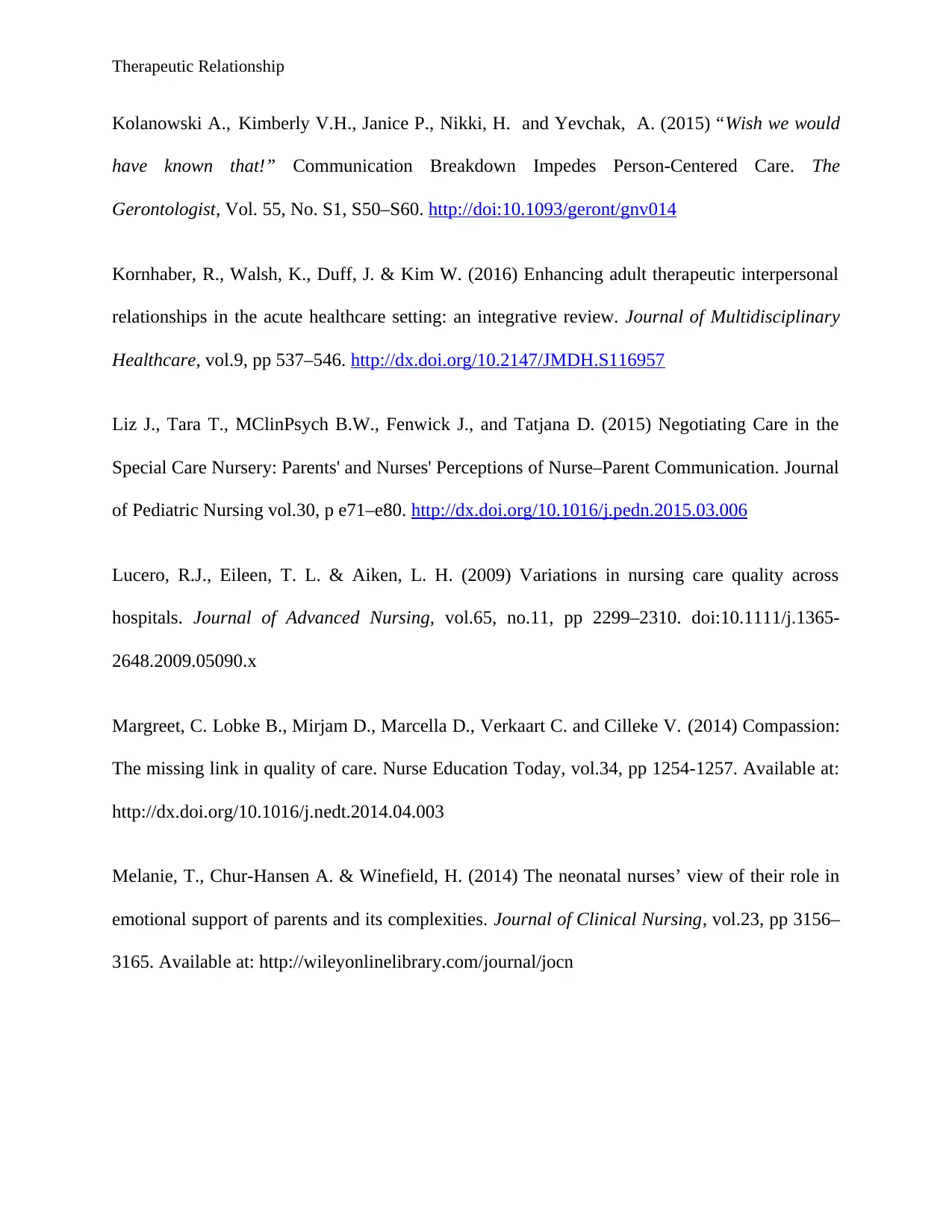
Therapeutic Relationship
Kolanowski A., Kimberly V.H., Janice P., Nikki, H. and Yevchak, A. (2015) “Wish we would
have known that!” Communication Breakdown Impedes Person-Centered Care. The
Gerontologist, Vol. 55, No. S1, S50–S60. http://doi:10.1093/geront/gnv014
Kornhaber, R., Walsh, K., Duff, J. & Kim W. (2016) Enhancing adult therapeutic interpersonal
relationships in the acute healthcare setting: an integrative review. Journal of Multidisciplinary
Healthcare, vol.9, pp 537–546. http://dx.doi.org/10.2147/JMDH.S116957
Liz J., Tara T., MClinPsych B.W., Fenwick J., and Tatjana D. (2015) Negotiating Care in the
Special Care Nursery: Parents' and Nurses' Perceptions of Nurse–Parent Communication. Journal
of Pediatric Nursing vol.30, p e71–e80. http://dx.doi.org/10.1016/j.pedn.2015.03.006
Lucero, R.J., Eileen, T. L. & Aiken, L. H. (2009) Variations in nursing care quality across
hospitals. Journal of Advanced Nursing, vol.65, no.11, pp 2299–2310. doi:10.1111/j.1365-
2648.2009.05090.x
Margreet, C. Lobke B., Mirjam D., Marcella D., Verkaart C. and Cilleke V. (2014) Compassion:
The missing link in quality of care. Nurse Education Today, vol.34, pp 1254-1257. Available at:
http://dx.doi.org/10.1016/j.nedt.2014.04.003
Melanie, T., Chur-Hansen A. & Winefield, H. (2014) The neonatal nurses’ view of their role in
emotional support of parents and its complexities. Journal of Clinical Nursing, vol.23, pp 3156–
3165. Available at: http://wileyonlinelibrary.com/journal/jocn
Kolanowski A., Kimberly V.H., Janice P., Nikki, H. and Yevchak, A. (2015) “Wish we would
have known that!” Communication Breakdown Impedes Person-Centered Care. The
Gerontologist, Vol. 55, No. S1, S50–S60. http://doi:10.1093/geront/gnv014
Kornhaber, R., Walsh, K., Duff, J. & Kim W. (2016) Enhancing adult therapeutic interpersonal
relationships in the acute healthcare setting: an integrative review. Journal of Multidisciplinary
Healthcare, vol.9, pp 537–546. http://dx.doi.org/10.2147/JMDH.S116957
Liz J., Tara T., MClinPsych B.W., Fenwick J., and Tatjana D. (2015) Negotiating Care in the
Special Care Nursery: Parents' and Nurses' Perceptions of Nurse–Parent Communication. Journal
of Pediatric Nursing vol.30, p e71–e80. http://dx.doi.org/10.1016/j.pedn.2015.03.006
Lucero, R.J., Eileen, T. L. & Aiken, L. H. (2009) Variations in nursing care quality across
hospitals. Journal of Advanced Nursing, vol.65, no.11, pp 2299–2310. doi:10.1111/j.1365-
2648.2009.05090.x
Margreet, C. Lobke B., Mirjam D., Marcella D., Verkaart C. and Cilleke V. (2014) Compassion:
The missing link in quality of care. Nurse Education Today, vol.34, pp 1254-1257. Available at:
http://dx.doi.org/10.1016/j.nedt.2014.04.003
Melanie, T., Chur-Hansen A. & Winefield, H. (2014) The neonatal nurses’ view of their role in
emotional support of parents and its complexities. Journal of Clinical Nursing, vol.23, pp 3156–
3165. Available at: http://wileyonlinelibrary.com/journal/jocn
Paraphrase This Document
Need a fresh take? Get an instant paraphrase of this document with our AI Paraphraser
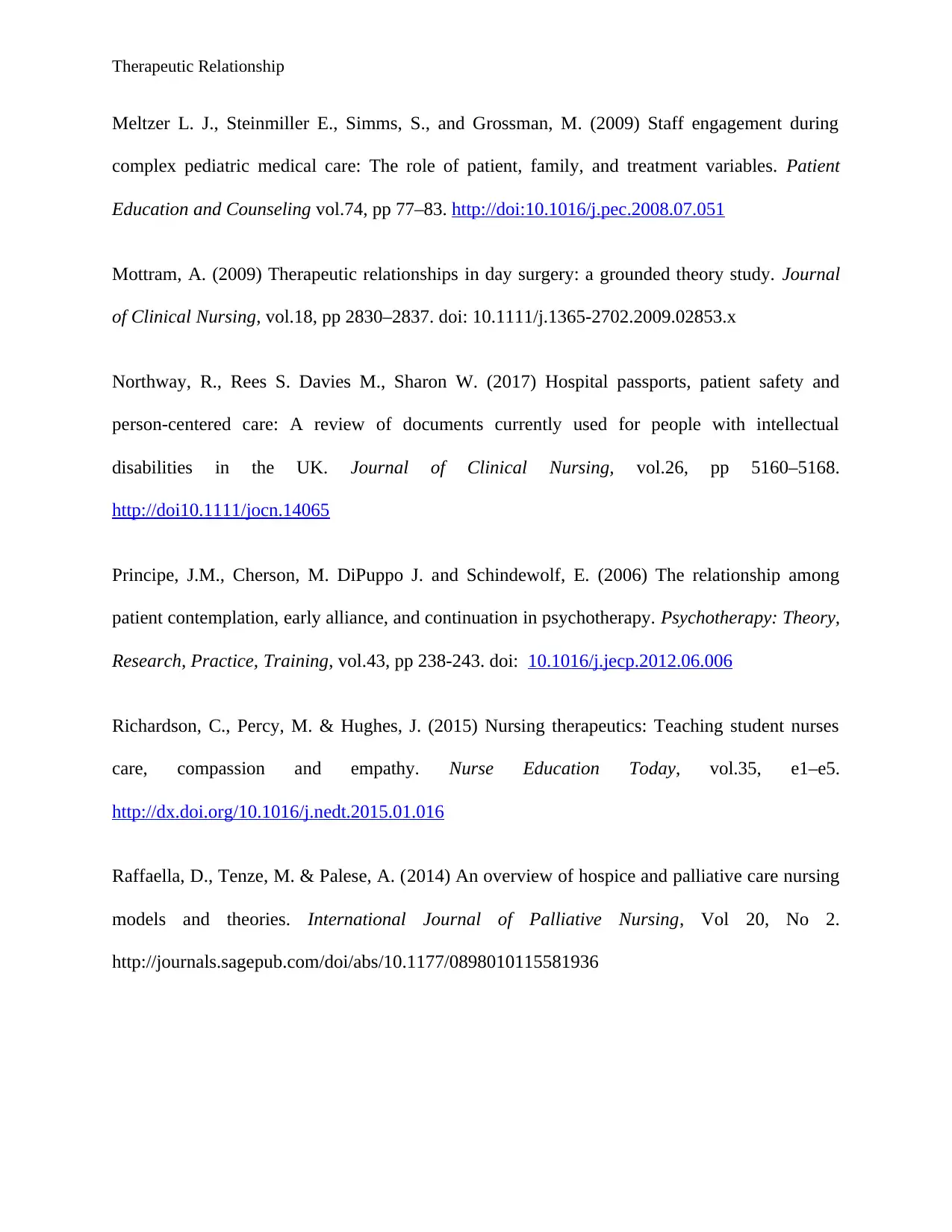
Therapeutic Relationship
Meltzer L. J., Steinmiller E., Simms, S., and Grossman, M. (2009) Staff engagement during
complex pediatric medical care: The role of patient, family, and treatment variables. Patient
Education and Counseling vol.74, pp 77–83. http://doi:10.1016/j.pec.2008.07.051
Mottram, A. (2009) Therapeutic relationships in day surgery: a grounded theory study. Journal
of Clinical Nursing, vol.18, pp 2830–2837. doi: 10.1111/j.1365-2702.2009.02853.x
Northway, R., Rees S. Davies M., Sharon W. (2017) Hospital passports, patient safety and
person-centered care: A review of documents currently used for people with intellectual
disabilities in the UK. Journal of Clinical Nursing, vol.26, pp 5160–5168.
http://doi10.1111/jocn.14065
Principe, J.M., Cherson, M. DiPuppo J. and Schindewolf, E. (2006) The relationship among
patient contemplation, early alliance, and continuation in psychotherapy. Psychotherapy: Theory,
Research, Practice, Training, vol.43, pp 238-243. doi: 10.1016/j.jecp.2012.06.006
Richardson, C., Percy, M. & Hughes, J. (2015) Nursing therapeutics: Teaching student nurses
care, compassion and empathy. Nurse Education Today, vol.35, e1–e5.
http://dx.doi.org/10.1016/j.nedt.2015.01.016
Raffaella, D., Tenze, M. & Palese, A. (2014) An overview of hospice and palliative care nursing
models and theories. International Journal of Palliative Nursing, Vol 20, No 2.
http://journals.sagepub.com/doi/abs/10.1177/0898010115581936
Meltzer L. J., Steinmiller E., Simms, S., and Grossman, M. (2009) Staff engagement during
complex pediatric medical care: The role of patient, family, and treatment variables. Patient
Education and Counseling vol.74, pp 77–83. http://doi:10.1016/j.pec.2008.07.051
Mottram, A. (2009) Therapeutic relationships in day surgery: a grounded theory study. Journal
of Clinical Nursing, vol.18, pp 2830–2837. doi: 10.1111/j.1365-2702.2009.02853.x
Northway, R., Rees S. Davies M., Sharon W. (2017) Hospital passports, patient safety and
person-centered care: A review of documents currently used for people with intellectual
disabilities in the UK. Journal of Clinical Nursing, vol.26, pp 5160–5168.
http://doi10.1111/jocn.14065
Principe, J.M., Cherson, M. DiPuppo J. and Schindewolf, E. (2006) The relationship among
patient contemplation, early alliance, and continuation in psychotherapy. Psychotherapy: Theory,
Research, Practice, Training, vol.43, pp 238-243. doi: 10.1016/j.jecp.2012.06.006
Richardson, C., Percy, M. & Hughes, J. (2015) Nursing therapeutics: Teaching student nurses
care, compassion and empathy. Nurse Education Today, vol.35, e1–e5.
http://dx.doi.org/10.1016/j.nedt.2015.01.016
Raffaella, D., Tenze, M. & Palese, A. (2014) An overview of hospice and palliative care nursing
models and theories. International Journal of Palliative Nursing, Vol 20, No 2.
http://journals.sagepub.com/doi/abs/10.1177/0898010115581936

Therapeutic Relationship
Rogers, C. (1957) The necessary and sufficient conditions of therapeutic personality change.
Journal of Consulting Psychology, vol.21, no.2, pp 95–103.
https://app.shoreline.edu/dchris/psych236/Documents/Rogers.pdf
Sandra, P. H., Annette, M. L. & Marlette, B. R. (2013) Personhood in Nursing Homes: Results of
an Ethnographic Study. Indian Journal of Gerontology, Vol. 27, No. 1, pp. 69–87
Sjögren, K., Lindkvist M., Per-Olof S., Karin Z. and Edvardsson, D. (2017) Organizational and
environmental characteristics of residential aged care units providing highly person-centered
care: a cross-sectional study. BMC Nursing vol .16, pp 44. http:// doi10.1186/s12912-017-0240-
4
Sonya, B. & Nancarrow, S. (2013) Effects of person-centered care on residents and staff in
aged-care facilities: a systematic review. Clinical Interventions in Aging, vol.8, pp 1–10.
http://dx.doi.org/10.2147/CIA.S38589
Wanda C. M and Hanson I.F. (2002) Negative Aspects of Therapy: Client Perceptions of
Therapists' Social Influence, Burnout, and Quality of Care. Journal of Social Issues, Volume55,
Issue1 https://doi.org/10.1111/0022-4537.00103
Rogers, C. (1957) The necessary and sufficient conditions of therapeutic personality change.
Journal of Consulting Psychology, vol.21, no.2, pp 95–103.
https://app.shoreline.edu/dchris/psych236/Documents/Rogers.pdf
Sandra, P. H., Annette, M. L. & Marlette, B. R. (2013) Personhood in Nursing Homes: Results of
an Ethnographic Study. Indian Journal of Gerontology, Vol. 27, No. 1, pp. 69–87
Sjögren, K., Lindkvist M., Per-Olof S., Karin Z. and Edvardsson, D. (2017) Organizational and
environmental characteristics of residential aged care units providing highly person-centered
care: a cross-sectional study. BMC Nursing vol .16, pp 44. http:// doi10.1186/s12912-017-0240-
4
Sonya, B. & Nancarrow, S. (2013) Effects of person-centered care on residents and staff in
aged-care facilities: a systematic review. Clinical Interventions in Aging, vol.8, pp 1–10.
http://dx.doi.org/10.2147/CIA.S38589
Wanda C. M and Hanson I.F. (2002) Negative Aspects of Therapy: Client Perceptions of
Therapists' Social Influence, Burnout, and Quality of Care. Journal of Social Issues, Volume55,
Issue1 https://doi.org/10.1111/0022-4537.00103
1 out of 15
Related Documents
Your All-in-One AI-Powered Toolkit for Academic Success.
+13062052269
info@desklib.com
Available 24*7 on WhatsApp / Email
![[object Object]](/_next/static/media/star-bottom.7253800d.svg)
Unlock your academic potential
© 2024 | Zucol Services PVT LTD | All rights reserved.





